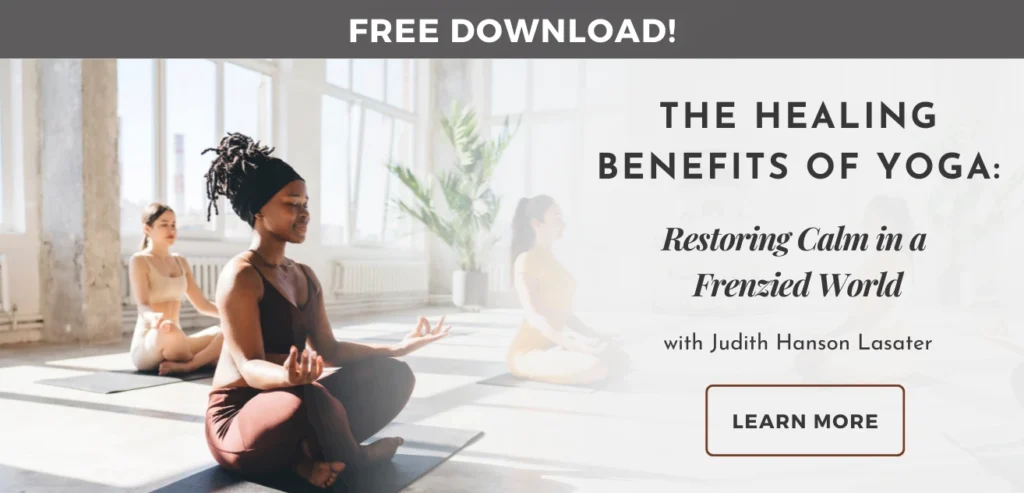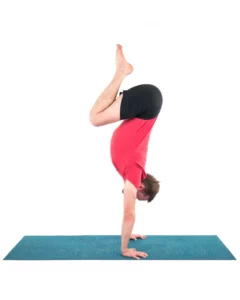Making Friends with Downward Dog Pose
How to Find Length through the Spine

Struggle with Downward Dog and ready to take it to the next level? This free yoga video with yoga teacher Sarah Bell will show you how.
Common Practice Problems in Downward Dog Pose
Downward-Facing Dog (Adho Mukha Svanasana) is one of yoga’s most ubiquitous poses. But that doesn’t mean that it’s easy!
While some yoga teachers even call this Downward Dog a “resting pose” between a series of Vinyasas or Sun Salutations, many students find this posture anything but relaxing.
Strain in the wrists, fatigue in the arms, and tightness in the hamstrings or calves are all common issues yoga students experience in Downward Dog. And because Downward Dog pose is so common in yoga classes, this presents a problem for many yoga students.
The #1 Trick to Tackle Downward Dog – Open the Superficial Backline
What’s the solution to finding greater ease in Downward Dog? One effective way to prepare for Downward Dog is to open the back of the body. This free yoga video with Sarah Bell does just that.
“Downward-Facing Dog is an inversion, and it requires that the backs of your legs, your buttocks, and your back are open and warmed up, ready to stretch,” says Sarah.
In this video, Sarah guides us through a series of postures targeted at creating length in the hamstrings, low back, and the soles of the feet in preparation for Downward Dog. These postures include the following:
- A prop-free variation of Reclining Hand-to-Big Toe Pose (Supta Padangusthasana) to open the hamstrings.
- Variations on Child’s Pose (Balasana) (photo below) to create space in the low back.
- Toe Squat to stretch the soles of the feet.
- A variation of Downward Dog at the wall reinforces the sense of opening in the back and hamstrings.
Finally, after creating length in the back body through each of these targeted postures, you are ready for the peak posture of the practice: (And yes, you guessed it!) Downward Dog.
Why This Downward Dog Yoga Sequence Works
Why is this yoga sequence so effective? You may be familiar with the old yoga trick of using foot massage to create more ease in Standing Forward Bend (Uttanasana). Students may notice they can find greater depth and ease in Standing Forward Bend after practicing about a minute of massage on each foot.
This yoga sequence operates on a similar principle to this foot massage trick. That is, the entire backline of the body is connected through the connective tissue.
The fascial chain involved in Downward Dog is the superficial backline. According to Anatomy Trains author Tom Myers, this continuous band of connective tissue runs from the bottom of the foot up the back of the body and ends at the top of the head.
The interconnection of these parts of the body through the connective tissue means that stretching the soles of the feet may create a sense of openness in the entire back body, perhaps being felt all the way up to the back of the neck.
Sarah Bell’s free yoga video takes an innovative approach to create length, ease, and stability in Downward Dog by targeting this superficial backline. Whether Downward Dog is your favorite posture or one you struggle with, this free yoga video will allow you to take your Downward Dog to the next level.
Go ahead, try it for yourself!
Also, read...
Desk-Friendly Yoga Neck and Shoulder Stretches
Dec 01 – Kathryn Boland, R-CYT, R-DMT
6 Yoga Poses to Expand Your Heart
Nov 24 – Charlotte Bell
Yoga Practice Tips: Why Listening to Your Body Might Not Be Enough
Nov 20 – Charlotte Bell
Related courses

Lacey Ramirez writes for YogaUOnline and is an RYT-500 & ERYT-200 yoga teacher, global health researcher, and writer based in St. Louis. Through her work, she seeks to make yoga accessible, inclusive, and equitable.
Lacey discovered yoga as a tool for centering during her years as a competitive runner. Since then, yoga has served as a way to connect with her body throughout her experience of pregnancy and parenthood. She teaches because she hopes others can use this sacred practice for calming, healing, and transformation.
As a yoga teacher, Lacey specializes in teaching restorative, Yin, prenatal, and trauma-informed Vinyasa yoga. She has also completed birth doula and prenatal/postnatal barre certifications and trainings. Additionally, she holds a Masters of Science in Global Health and Population from Harvard T.H. Chan School of Public Health. To learn more and connect, visit her website laceyramirez.com
 Sarah Bell (ERYT-500, YACEP) has been teaching yoga for more than twenty-five years. She was on the Yoga Works Teacher Training Program faculty for fifteen years, having trained hundreds of teachers in both the 200-hour Introductory Courses and the 300-hour Professional Programs throughout the country and abroad. She is the creator of Speaking of Yoga, a voice and communication course for yoga teachers, and Beyond the Postures, a course that introduces yoga philosophy, anatomy, pranayama, and meditation to curious yoga practitioners. She mentors yoga teachers along the path as they find their voice and refine their skills. For more information on her upcoming retreats, courses, and classes, find her at www.sarahbellyoga.com
Sarah Bell (ERYT-500, YACEP) has been teaching yoga for more than twenty-five years. She was on the Yoga Works Teacher Training Program faculty for fifteen years, having trained hundreds of teachers in both the 200-hour Introductory Courses and the 300-hour Professional Programs throughout the country and abroad. She is the creator of Speaking of Yoga, a voice and communication course for yoga teachers, and Beyond the Postures, a course that introduces yoga philosophy, anatomy, pranayama, and meditation to curious yoga practitioners. She mentors yoga teachers along the path as they find their voice and refine their skills. For more information on her upcoming retreats, courses, and classes, find her at www.sarahbellyoga.com Recent articles
Desk-Friendly Yoga Neck and Shoulder Stretches
Dec 01 – Kathryn Boland, R-CYT, R-DMT
6 Yoga Poses to Expand Your Heart
Nov 24 – Charlotte Bell
Discovering the Living Body: A Yoga Teacher’s Revolutionary Insight on Fascia
Nov 22 – Eva Norlyk Smith, Ph.D.
Categories
Upcoming courses
Recent articles
Almost there...
Sorry, we couldn't find anything...
Yoga Practice Tips
Desk-Friendly Yoga Neck and Shoulder Stretches
If you’re reading this, you’re a human living in 2022. If you’re a human…
Dec 01 – Kathryn Boland, R-CYT, R-DMT
Yoga Practice Tips
6 Yoga Poses to Expand Your Heart
Have you ever been in a yoga class when someone (maybe you) experienced a…
Nov 24 – Charlotte Bell
Anatomy
Discovering the Living Body: A Yoga Teacher’s Revolutionary Insight on Fascia
What if everything you thought you knew about your body was too static? In…
Nov 22 – Eva Norlyk Smith, Ph.D.




